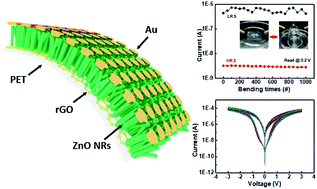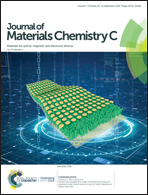Solution-processable zinc oxide nanorods and a reduced graphene oxide hybrid nanostructure for highly flexible and stable memristor†
Abstract
Low-dimensional nanomaterials have attracted increasing attention in flexible electronics designing due to their extraordinary electrical and mechanical properties. In this communication, one dimensional (1D) zinc oxide nanorods (ZnO NRs) and a two dimensional (2D) reduced graphene oxide hybrid nanostructure were synthesized via a solution-processable strategy. The hybrid nanostructure based memristor possessed a non-volatile flash memory feature that is ascribed to the formation and rupture of oxygen-vacancy-assisted conductive filaments. The concentrated resistance and switching voltage may result from the facile formation of straight and extensible conductive filaments along ZnO NRs. Impressively, the device can operate without significant degradation in electrical performance when undergoing mechanical bending for 1000 cycles with a small bending radius of 6 mm. The insight gained from this communication may afford new opportunities for design of high-performance flexible memory electronics.

- This article is part of the themed collection: 2019 Journal of Materials Chemistry C HOT Papers


 Please wait while we load your content...
Please wait while we load your content...